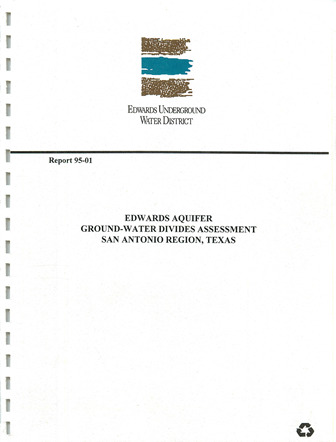Edwards Aquifer Ground-Water Divides Assessment, San Antonio Region, Texas

| Author | LBG-Guyton Associates |
| Year | 1994 |
| Description | Hydrogeologic study on location of groundwater divides in Hays and Kinney Counties |
| Report Number | 95-01 |
| Publisher | Edwards Underground Water District |
| Location | Edwards Aquifer, Balcones Fault Zone, San Antonio Segment, Hays County, Kinney County |
| Cover | View Download |
| File | View Download |
| Summary |
|
The Edwards aquifer in the San Antonio region extends approximately 180 miles from the ground-water divide in Kinney County on the western end to the ground-water divide in Hays County on the northeastern end. The exact delineation of the divides has not been clearly defined and has not been located in the same place through the history of hydrogeologic studies of the Edwards aquifer. The areas on the western and eastern ends of the Edwards aquifer in the San Antonio region were studied to evaluate and better delineate the ground-water divides, with the results discussed in this report. In Hays County, a mound in the water table of the recharge zone results from recharge being focused in an area located along Onion Creek. This area has extensive exposures of Kirschberg evaporite member and numerous faults, which are favorable for the development of secondary porosity and permeability. In the artesian pan of the aquifer, the water-level high may be associated with a preferred flowpath that is directed from the Onion Creek recharge area into the artesian pan of the aquifer, possibly being modified by an unknown subsurface geologic structure. The water-level high in the artesian pan of the aquifer is formed in part by the effects of pumpage in the vicinities of the Cities of Kyle and Buda located on either side of the high and the relative lack of pumping in the area between the two cities. Water levels measured toward the end of summer 1994 in the artesian pan of the aquifer appear to be below the level of San Marcos Springs Lake. This suggests that, during times of lower water levels, the artesian part of the aquifer in this area may not supply water to San Marcos Springs but instead to pumpage near Kyle and Buda and to Barton Springs. A water-level high between Kyle and Buda that is shown by the summer 1994 measurements indicates that flow during this period does not move past San Marcos Springs to Banon Springs. Based on the data from this report, the groundwater divide in Hays County should be located generally between the Cities of Buda and Kyle in the artesian part of the aquifer and along Onion Creek in the Edwards aquifer recharge zone. In Kinney County, several anticline and syncline folds that plunge to the southwest channel water like a large sheet of corrugated tin toward Las Moras and Pinto Springs. Intrusions of essentially impermeable igneous rocks that generally occur along the axes of the anticlines, which are folded upward, help to magnify the constraining effect of the folds. The intrusions act as a “grout curtain” where the igneous material has been intruded into the Edwards limestone. Water levels have shown some minor changes through time, but no effects from the filling of Lake Amistad have been detected in the vicinity of the ground-water divide in Kinney County. Two noses appear on the water-level contour maps for Kinney County, both reflective of the underlying anticlines and synclines. However, water-level measurements indicate that a component of flow comes past Las Moras Springs from west to east toward the City of Uvalde. As a result, the divide should be placed to the west of Las Moras Springs. It probably runs to the north toward Pinto Mountain and then along a topographic high in the unnamed escarpment north of Pinto Mountain. Because stream losses in the West Nueces River are presently used for recharge calculations for the San Antonio region of the Edwards aquifer and water-level contours indicate that a portion of this recharge is moving toward Pinto and Las Moras Springs, discharge of both these springs should be considered as part of any water-balance calculations for the Edwards aquifer in this area. |
Search for Documents
Advance Search
Explore EAA's Scientific Reports
- All Reports
- Water Quality
- Climatology
- Surface Water / Groundwater Relationship
- Biology
- Springs, Groundwater Discharge
- Archaeology
- RZ Protection
- Aquifer Levels
- Remote Sensing
- Precipitation
- Overview Studies
- Modeling
- Hydrology and Hydrogeology
- History
- Groundwater Recharge, Recharge Zone
- Groundwater Movement
- Geomorphology and Caves
- Weather Modification
- Geology
- Water Use and Conservation
- Geochemistry
- Water Resources Planning and Management
- Floods and Drought
